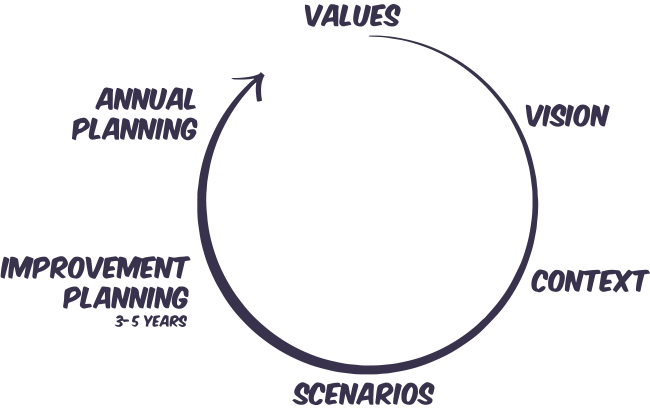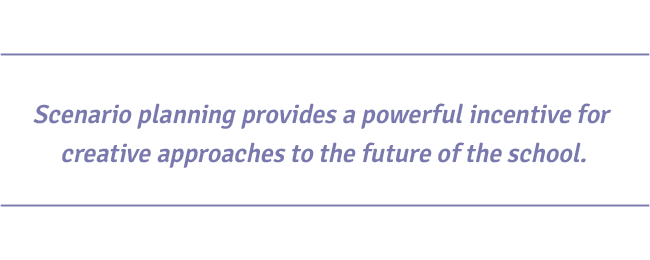Professor John West-Burnham discusses his thoughts on leadership and how to use strategic thinking to develop credible and successful leaders.
It could be argued that one of the defining features of successful leadership is a commitment to securing the long-term future of the organisation. It is the function of governance to ensure that leaders do actually focus on the future as an essential part of their work and to hold leaders to account in translating aspirations into practice.
The problem is that the short term is often more compelling and demanding than the long term – the operational can drive out the strategic; the urgent supplants the important.
Successful and credible leaders are able to tell compelling and credible stories about the future – they are leaders to the extent that people accept and value the future they describe.
We value Martin Luther King Jr, Nelson Mandela, Aung San Soo Chi and Vaclav Havel because of their ability to articulate the future and to secure the commitment of others to that future.
Preferred scenarios
One approach to strategic thinking, developed by the Shell oil company following the economic uncertainties of the 1970s, is to think in terms of preferred scenarios. It might be that the energy and resources expended on strategic planning would be better deployed elsewhere.
Certainly many large businesses have stopped long-term strategic planning because of the uncertainty and ambiguity of the modern world. Shell has been using scenario planning for 30 years.
Scenarios are stories, narratives that help to work out the possible options for the future by developing a range of models with varying degrees of detail and alternative possibilities.
Crucially, the stories can be changed and developed – scenarios recognise the dynamic nature of the world in which education functions. Scenarios are essentially descriptions of a preferred future.
Spotlight on the future
On our current level of understanding this is where we would prefer to be in the future. We all use scenarios in every aspect of our lives.
A child might switch between being a racing driver, a nurse, or an explorer, once working with animals has been excluded. Couples will explore the possibilities of their lives together by speculating about their future options: how many children, dog or cat? People approaching the end of their working lives will begin to explore the options for retirement.
Teachers and school leaders will often have ambitions for their professional futures that are best seen as possible scenarios.
Scenario planning
Scenario planning in schools is grounded in three elements: the values that are fundamental to the school; the vision for the school in the future; and a pragmatic awareness of the history of the school, the prevailing policy context and the constraints limiting the school’s potential development.
For schools, and as for the public sector in general, government policy plays a very significant, if not dominant, role in establishing the context for planning.
For example, under the previous administration the prevailing policy was focused on ‘Every Child Matters’; this has been replaced by ‘Close the Gap’.
The intention of both policies is essentially the same but their implications for schools are very different, especially given the economic context and the ideological framework underpinning them. School-based scenario planning therefore needs to reconcile the school’s moral purpose with an objective understanding of the prevailing policy climate.
Once the three foundation stages
(values, vision and context) have been established it is possible to develop a range of scenarios for the future; some of which might be naively utopian, others pragmatic, and others pessimistic.
The key role of school leaders and
governors is then to select the optimum scenario – the preferred future given all the variables that have been identified.
This allows the actual planning process to be established for the medium term (three to five years) which in turn can be translated into the annual planning process that is linked into the budget – usually the final arbiter of what is possible.

Engagement and involvement
As with any form of planning, a high degree of engagement and involvement is necessary to secure consent and commitment. Therefore there is a need to develop a process that is more than a tokenistic deference to consultation but rather genuine participation from all those who have an interest in the school’s future – and that certainly means governors and all staff and pupils but also their parents and probably the wider community.
Other sources of the possible components of scenarios might include a commitment to certain key educational principles, such as becoming genuinely inclusive and equitable; research about successful innovations in schools; awareness of the implications of long-term policy-making by government; demographic trends in the community and possible collaboration with other schools.

The utopian, naive, scenario might well serve as a powerful catalyst for change. Equally, scenario planning can be highly practical and help to focus thinking on implementation.
For example, limited resources might well compromise scenarios; it is therefore important to develop capacity in leading innovation to generate resources.
In addition, the governing body and leadership team will need to develop confidence in working at a strategic level – indeed, moving from the operational to the strategic is one of the key challenges facing school leadership in the current, turbulent, environment.
Perhaps the most important outcome of adopting the scenario planning approach is that it reinforces moral purpose and can serve to engage and motivate – it’s an interesting, challenging but primarily creative process. It values imagination and creativity as much as financial planning and implementation (equally necessary concerns). SR
Possible Scenarios:
- Every pupil and member of staff has an iPad that is the basis of all teaching and learning strategies, student work, assessment and monitoring progress. The school develops virtual textbooks so that the cost of curriculum materials is substantially reduced, as is photocopying.
- The school becomes a community resource with educational provision from cradle to grave – e.g. education 3-19 with pre and post compulsory provision; and community-based approaches to support well-being such as integrated health strategies.
- A cluster of primary schools agrees to federate in order to secure their distinctive ethos, improve the efficiency of their resource management and develop a common approach to the curriculum and teaching and learning. The scenario includes shared review and improvement strategies, collaborative approaches to CPD.


